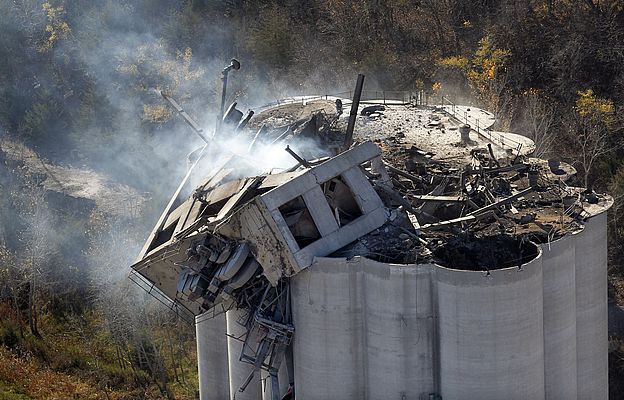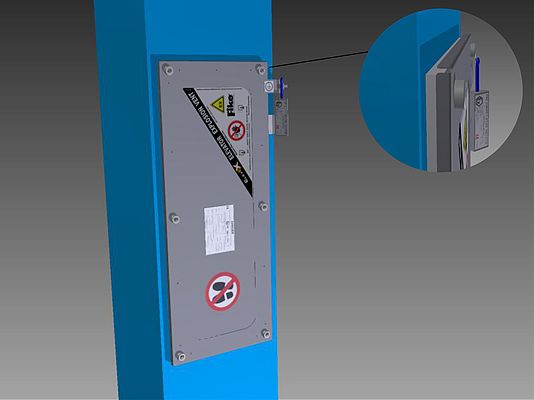Bucket elevators are widely used to transport agricultural bulk materials such as grains, seeds or pellets from ground level to the top of storage silos. Buckets are attached to a vertical belt, rotating around a drive pulley in the head section and a free pulley in the boot section. Metal casings are built around the belts and pulleys to prevent spillage. High rotation speeds maintain the transport capacity.
History shows a high number of dust explosions originate in bucket elevators and spread into adjacent galleries and silos. The construction and operation of bucket elevators is such that combustible dust clouds and potential ignition sources are omnipresent. In the grain handling industry, the bucket elevator is considered among the most dangerous pieces of equipment. Although the increased application of good housekeeping practices and explosion prevention strategies have reduced the number of explosions, elevator explosions continue to be reported, causing considerable property losses, human suffering and sometimes, loss of life. The October 2011 devastating explosion at the Bartlett Grain Company near Atchison, Kansas claimed six lives and injured several others.
If the bucket elevator is conveying a combustible dusty product containing a considerable amount of fines (< 0.5 mm), explosive dust clouds may arise frequently during normal operation. Dust can stick to the inner surfaces of the bucket elevator and dust layers can accumulate over time to form an explosive atmosphere if they become dispersed by vibration. Although dust extraction is often used to reduce the dust emissions, it cannot eliminate explosive dust clouds completely.
With bucket elevators there is also a high risk of ignition due to fast mechanical movement. The following ignition sources are the most reported upon: Hot surfaces arising from friction, mechanical sparks from lose parts colliding with the casing, electrostatic discharging of belt, buckets or any conductive installation component that is not well earthed, metal or glowing parts that enter the elevator with the bulk product, and finally welding, grinding or cutting works on an uncleaned elevator. In addition to strict cleaning, maintenance and permit to work systems, the correct choice of construction materials, application of clearances, belt slippage and misalignment detectors, bearing temperature detectors and the use of upstream product cleaners, safety grids, magnetic separators and hot particle detectors will reduce to risk on ignition considerable, however, they are almost never sufficient to reduce the explosion hazard to a sufficient low level. Additional explosion mitigation measures are mandatory, unless proved otherwise.
The most used explosion mitigation method is explosion venting. Fike ELEGUARD burst or venting panels are installed at strategic locations along elevator legs and head, rupture at moderate explosion overpressure and prevent that the elevator casing itself is destroyed. The burst pressure, size, number and location of the panels is key to effective protection. Typical leg inter-vent spacing is 3 m, 6 m or 12 m, depending on the mechanical strength of the elevator casing and explosion reactivity of the dust. ELEGUARD panels fit on most elevator leg and head geometries, and have integrated bottom and top frame allowing fast and safe installation with a minimal amount of footprint, and without dangerous welding work required.
If the elevator is located indoors or in occupied areas, flameless venting is used to protect people and equipment from freely discharged flames. A Fike ELEQUENCH is a box of flamefilter material installed on top of an ELEGUARD panel, allowing the panel to open within the box and forcing flame to pass through the flamefilter where it is extinguished by cooling. The low weight of ELEQUENCHES and optimal venting efficiency ensure easy installation with minimal footprint.
Venting and flameless venting technologies are relatively inexpensive, have low maintenance requirements and can be rapidly installed and replaced. However, they have also several weaknesses: they do not prevent explosion propagation to adjacent feed or receiving systems, they do not prevent post explosion fire damage, they cannot be used with toxic or environmentally harmful materials, and in some cases a lot of devices are needed for low pressure structures.
Superior protection to tackle these weaknesses is achieved by explosion suppression. Then bottles with extinguishing agent are used to stop the combustion process in an early phase. Within milliseconds, the beginning explosion is detected, the bottle valves opened, and an excess of agent discharged into the elevator. Fike HRD suppression bottles are installed on free elevator volumes where the ignition risk is the highest, such as head, boot and possible intermediate chutes. Explosion detection is achieved by pressure and optical detectors. Pressure detectors will not respond until the explosion pressure has risen to a detectable set level and the optical detector will signal within milliseconds once the flame is visible. A combination of both pressure and flame detection will ensure that suppressors activate and keep the explosion overpressure and propagation extension to a minimum. Fike 3” HRD radial suppressor nozzles uses minimal space on the head or boot casing and direct injected suppressant agent into the elevator such that explosion propagation risk out of head or boot is minimized. To eliminate the risk of explosion propagation to connected areas and equipment completely, additional suppression bottles are installed on the connecting ductwork.
Although the initial investment cost with explosion suppression is higher than with explosion venting and regular specialized maintenance is required, it provides full extinguishment of the fireball, and prevents explosion propagation to feeding or receiving systems, which is often the most critical measure in the hazard reduction.
In addition to offering a full range of dedicated explosion mitigation devices that minimize capital investment and cost of ownership, Fike has over 70 years of experience with designing the most effective elevator protection system. Fike executes its own explosion experiments in representative equipment to get a deeper understanding on the course of elevator explosions and optimize protection schemes. Fike’s in house structural strength engineering capabilities and explosion testing laboratory have been used in a multitude of projects for the determination of the explosion pressure shock resistance of the elevator casing and the explosion reactivity of the fines fraction of the bulk product conveyed. Finally Fike provides by default professional help with the application of public elevator protection guidelines such as NFPA 61, NFPA 68, VDI 2263 Part 8 and TR 16829.



















